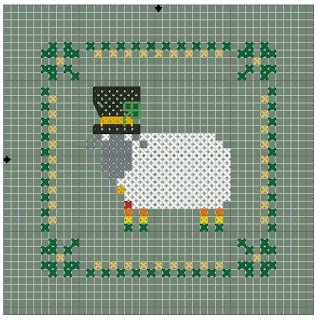Godey's Canadian or Templar's Cap
A little housekeeping;
First, I am not a professional knitter. I am a sewist. My notes are most likely going to be using some sewing world terms, so if you have any questions please leave a comment and I will do my best to help you through any problems you may encounter.
Other notes of interest - READ ALL PLEASE
I do not know what year this is from. This appears in the book A treasury of needlework projects from Godey’s lady’s book. The author does not designate the issue which the patterns are from.
I used the knit cast-on method on the chin stitches, and I found that it lacked some necessary stretch under the chin. The rest of the ribbing makes up for it, but you should choose a more flexible cast on method when you add the 24 stitches to join the neck and start the neck ribbing.
Ribbing needs to be done in numbers divisible by 3.
I do not include stitch counts for different sizes.
You will need to know your basic head measurements and check the length of your knitting frequently to assure a good fit. I knit this with only the measurements included in the pattern and it fits me but I am small....like Victorian size small.
There is an error in the original pattern where it calls for 22 inches knit plain to shape the head piece. It should read 22 STITCHES.
Choose a yarn with S T R E T C H.
I add in slip stitches because it really helps with the construction.
I did not gauge as I use fingering, sock, baby or sport weight yarn in just about everything I knit.
I'm a heathen, I know. I don't gauge! The audacity! The horror!
Supplies I used:
1 hank of fingering weight merino with bounce 440 yards
4 14" long steel dpns - 3mm
6" long wooden ruler to check length as I went
Row Counter
Stitch Markers
Long stitch holder (those MCM aluminum giant safety pin things)
Snips
Needle
Lots of coffee and two glasses of wine...not all at once of course.
Original Pattern from
A Treasury of needlework projects from Godey’s lady’s book. Wiczyk, A. Z. (1972) ISBN 0-668-02702-9
1 hank of fingering weight merino or other yarn with bounce 440 yards
4 14" long steel dpns - 3mm
6" long wooden ruler to check length as you go
Your measurements (see diagram at the top of the page)
Row Counter
Stitch Markers
Long stitch holder (those MCM aluminum giant safety pin things)
Snips
Needle or other end weaving tool
Cast on 72 stitches.
Knit plain to 5 1/2 inches (42 rows)
To shape the head piece -
k 47 stitches, k2tog.
The next part is worked as if working a sock heel.
Turn piece. *Slip 1, knit 22, k2tog* turn. Repeat from *until 24 stitches remain on needle.
Ribbing for face opening -
Using a second needle, pick up all stitches on the same side you ended the last stitching on. Continue knitting to bottom adding 1 extra stitch. (43)
Slip 1, knit 42 sts + 12 of the 24 stitches on first needle.
Use first needle with 12 stitches on it to pick up stitches on remaining side + cast on 1 extra (43)
Knit 12 + 43 (55)
You will now knit back and forth using a third needle.
Slip first stitch, knit 3, purl 3 to last stitch, knit last stitch, turn. (110)
Slip first stitch, purl 3, knit 3 to last stitch, knit last stitch, turn. (110)
Repeat the last 2 rows to create 2 inches of ribbing.
To form neck -
Cast off in rib, leaving 1 loop remaining on needle.
Using that needle cast on 24 using a stretchy cast on. (25)
Join to main bonnet by picking up and knitting 16 stitches. (41)
Use the opposite side of the same needle to pick up and knit 17 stitches of the bonnet. (58)
Use an additional needle to pick up the rest of the bonnet stitches until you return to the start of the round. At this point you can either continue on 2 needles or divide the long cast on evenly onto 2 for a total of 3 needles. If you choose to knit in the round on a cable place stitch markers at the ends of the first 58 stitches you divided, it will make dividing for flaps easier for you later on.
Knit all in k3 p3 ribbing for 4-6" depending on the length of your neck. (Measurement 3) Add additional stitches to keep rib count divisible by 3 if necessary.
To form flaps -
Take the 58 stitches from the front needle and move them onto a large stitch holder.
Arrange stitches of rear flap onto one needle.
Slip first stitch of each row.
Work rear flap in plain knitting for 5", or longer if you desire. When at desired length begin decreases. k2tog, knit plain to last 2, k2tog. Repeat decrease until 50 stitches remain on needle.
Use Icelandic bind off, snip, leaving a tail and weave in.
Rejoin yarn to the piece using a weaver's knot or method of choice.
Move to remaining 58 stitches, placing them from the stitch holder back onto a needle.
Slip first stitch of each row.
Work in plain knitting for 5" or longer if you desire. When at desired length begin decreases. k2tog, knit plain to last 2, k2 tog. Repeat decrease until 25 stitches remain on needle.
Use Icelandic bind off, snip, leaving a tail and weave in.
Weave in all ends.
Enjoy!








Comments
Post a Comment